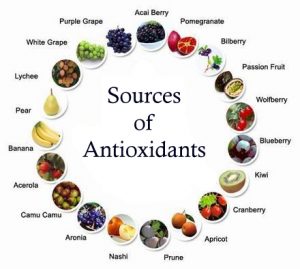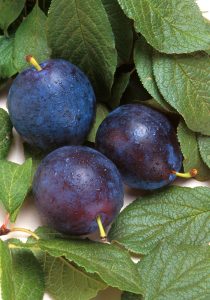- Introduction
- Organic Farming Elevates Antioxidant Concentrations
- Maximizing Antioxidant Intake
- Other Resources
Introduction

In the then-newly issued, 2005 Dietary Guidelines for the Nation, the U.S. government essentially doubled the recommended number of servings of fruits and vegetables from the familiar “Five-A-Day” to nine to thirteen servings, depending on a person’s size and daily overall caloric needs. This huge increase was recommended in large part by the hope of improving public health by sharply increasing antioxidant intakes.
Here we explain why antioxidants are so important and what they are. We also describe rules-of-thumb for those looking for the easiest way to get the highest antioxidant bang for your caloric and food-dollar buck.
Why are antioxidants important and where are they found?
Antioxidants combat inflammation and lower heart disease and cancer risk. They promote strong immune system responses, and help tip the odds toward graceful aging. Some antioxidants are manufactured in our bodies on an essentially continuous basis, but our innate capacity to synthesize antioxidants becomes less efficient as we age.
Our bodies are totally dependent on food for some critical antioxidants, including vitamins C and E.
Antioxidants are naturally-occurring compounds in fruits, vegetables and whole grains. The benefits of antioxidants arise from their impact on “free radicals,” which are unstable oxygen and nitrogen molecules produced in our cells as a result of:
• Breaking down food,
• Normal cell respiration,
• Vigorous exercise, and
• Exposure to chemicals.
 “Free radicals” carry an electrical charge that makes them unstable, because they are highly reactive. These molecules can erode the integrity of cell walls. Once in cells, they can disrupt cellular processes and damage the DNA in cells. They promote aging and multiple disease processes.
“Free radicals” carry an electrical charge that makes them unstable, because they are highly reactive. These molecules can erode the integrity of cell walls. Once in cells, they can disrupt cellular processes and damage the DNA in cells. They promote aging and multiple disease processes.
Antioxidants produced by the body, and those ingested through the diet, neutralize the electrical charge of free radicals, eroding their capacity to disrupt and damage cells. The more antioxidants circulating in a person’s body, the more free radicals will be deactivated.
But the life cycle of antioxidants in the human body is short-lived (typically well less than 24 hours). Most of the antioxidants in the blueberries an individual enjoyed for breakfast have worked their magic by dinner, because by then they are metabolized and on their way out. This is why people need to consume antioxidant-rich fruits and vegetables at least a couple of times a day, every day. As noted above, but worth emphasizing, the elderly become progressively more dependent on antioxidants in food, because aging erodes the body’s natural capacity to produce indigenous antioxidants.
The vast majority of Americans do not get enough antioxidants in their daily diets, and indeed most people need to double antioxidant intake to take full advantage of their health-promoting potential. This is why the federal government so dramatically increased the number of recommended daily servings of fruits and vegetables in 2005.
Increasing antioxidant intake is easy if three simple rules are followed:
1. Eat 9 to 13 servings of fruits and vegetables throughout the day.
2. Pick a diverse array of brightly colored fruits and vegetables.
3. Consume fruits and vegetables in, or as close to their natural form as possible.
Seeking out organic produce and processed fruit and vegetable products will also increase antioxidant intakes by about 20% per serving or gram consumed.
Organic Farming Elevates Antioxidant Concentrations
 As discussed in The Organic Center’s State of Science Review about antioxidants, available on Hygeia Analytics as a two-page summary and full report, organic farming has been shown to yield higher antioxidant concentrations than conventional farming. The answer to the question of why is complex, with several related factors that come into play depending on the soils and climate where an organic crop is grown, pest pressure, when produce is harvested, and how it is handled from the field to the consumer.
As discussed in The Organic Center’s State of Science Review about antioxidants, available on Hygeia Analytics as a two-page summary and full report, organic farming has been shown to yield higher antioxidant concentrations than conventional farming. The answer to the question of why is complex, with several related factors that come into play depending on the soils and climate where an organic crop is grown, pest pressure, when produce is harvested, and how it is handled from the field to the consumer.
When plants are under stress from pests or environmental factors (like intense sunlight), they produce a diverse array of natural chemicals called secondary plant metabolites (SPMs), many of which are antioxidants. SPMs also are responsible for giving fruit and vegetables their bright coloring and distinctive flavors.
Plants on organic farms typically have to deal with higher levels of pests than plants on nearby conventional farms, where pesticides are routinely applied. For this reason, plants on organic farms more fully engage their innate defense mechanisms. In the course of doing so, organic crops elevate antioxidant concentrations that end up promoting human health too.
A second explanation arises from how fast conventional vs. organic plants grow and mature. Antioxidant levels tend to be higher in organic fruit and vegetables, because they tend to grow slower and mature at a smaller size, compared to fast growing, heavily fertilized conventional produce.
The nutrient “dilution effect” arises from the tendency for vitamins, minerals and antioxidant levels in plants to be reduced – or diluted – in large, fast growing and high yielding crops, whether conventionally or organically grown. Plants given ample or excessive fertilizer and plenty of water convert the extra water and nutrients taken up by roots into simple carbohydrates and starches. In the case of many fruits, this makes produce juicy and sweet, but also dilutes the concentrations of health-promoting vitamins and antioxidants.
Maximizing Antioxidant Intake
How can a person maximize antioxidant intake per calorie of food consumed?
It is actually pretty straightforward. The antioxidant report includes Tables 2 and 3, which rank common foods by their antioxidant capacity, including antioxidant units per serving, average serving size, calories per serving, and ORAC per calorie (Oxygen Radical Absorbance Capacity, or ORAC, is a method used to measure antioxidant levels). This table is a real eye-opener for those wanting to improve dietary choices.
There are other proven strategies to routinely increase daily antioxidant intake:
• Hand-squeeze fruit juice yourself whenever you can. Commercial squeezing (plus pasteurizing) depletes about 20 percent more of the antioxidants in raw fruit than hand squeezing.
• When selecting oils and juices, look for brands that are not processed at high temperatures or under extremely high pressures, these methods of oil extraction break down antioxidants.
• Enjoy processed tomato products, since cooked tomatoes, tomato soup, and tomato sauces all have higher concentrations of certain, key antioxidants compared to raw tomatoes.
• Produce that is picked and consumed ripe has higher levels of most antioxidants.
• Eat a variety of produce, and frequently every day.
Related Keywords:
